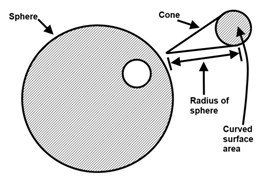Radiometric Quantities
Radiometric quantities are measurements related to the amount of radiation or energy emitted or absorbed by a material or object. Some examples include:
- Energy
- Power
- Irradiance
- Exitance
- Steradian
- Intensity
- Radiance
- Reflectance
- Absorptance
- Transmittance
Energy
The ability to do work is called energy for the measurement of energy the unit used is joule.
Joule is equivalent to the energy needed to lift 0.738 pounds one foot.
In fact a single 100 watt light bulb emits 100 joules of energy every second so it is clear that
Joule = watt/sec
Pulsed lasers are rated by the amount of energy they can produce in each pulse. Some lasers only produce micro joules per pulse while some produce hundreds of joules per pulse. In many cases the energy produced by a laser is converted into heat energy when the light strikes a surface. Unit used for heat measurement is calorie.
Calorie (according to physics) is the amount of heat required to raise the temperature of 1 gram of water from 14.5o C to 15.5o C. But here calorie can be defined as: If one joule of light energy is converted entirely into heat then it would produce approximately 0.239 calories. So relationship between joule and calorie is
1 calorie = 4.18605 joules
Or
1 joule = 0.239 calories.
Power
The rate at which energy is delivered is called power, denoted by P and measured in watts (w). to calculate power divide the amount of energy delivered by the amount of time the energy is present
I.e. power = energy/time
The time is an important factor in power equation. I.e. when two lasers deliver the same amount of energy then power in these two will be that one which delivers in less time. Means in lasers the fastest delivery of amount of energy is the sign of powerful laser.
Irradiance
The power per unit area is called irradiance denoted by I and having a unit of watt/sq.cm.
Sometimes irradiance is often called the power density or concentration of light power.
Formula for irradiance is
Irradiance = power/Area
surface area = πR2 but R= diameter / 2
Where area = π(diameter)2/2 ------------(eq. 1)
The formula for area in eq.1 is area of a circle, we select it because most of laser beam are circular and they produce a circular spot when they strike a surface perpendicularly.
Note that irradiance is the measurement of light at target only.
Exitance
A measurement of power per unit area at the output aperture of the laser source is called exitance.
Since exitance is measurement of light at source only therefore exitance is determined by dividing the output power from the laser by the unit area of the laser beam as it exit from the laser.
Formula used for exitance is
Exitance = output power / Area
Where
Area = π(output aperture / diameter)2 / 4
Steradian
The steradian denoted by “st” is the measurement of solid angle, where solid angle is the three dimensional angle.
The steradian can be visualized as a cone shaped section of the sphere as shown.

The curved surface area of this cone is always equal to the square of the sphere radius. In other words, the ratio of curved surface area to (radius)2 is 1:1. In relating steradians to solid angles, the steradian is a reference or standard solid angle. All other solid angles are described as fractional parts or multiples of the steradian.
Equation for determining the solid angle in steradian is
W = A/ R2
Where
W = solid angle in steradian
A = curved surface area
R = radius of the sphere.To determine the number of steradians in complete sphere, we know that in this case
A = 4πR2 /R2 = 4π
This equation shows that an entire sphere equals a solid angle of 4π steradian.
Intensity
Intensity is the measure of the power exiting the laser source per unit solid angle or steradian. The unit of intensity is watts/steradians. Its formula is
Intensity = power / solid angle
Intensity is the characteristic of the source of light and is not dependent upon the target, upon which the light strikes. It does not vary with the distance from the source. Remember that a laser is much more intense than most powerful light source, because laser light is confined to small solid angle.
Radiance
Radiance is the radiometric measurement that is most closely related to our visual sensation of brightness. It is a measurement of the light source and like intensity it does not depend upon the target location.
Radiance is the most comprehensive measurement of light source because it combines the quantities of power, solid angle and area of emitted beam means aperture area.
Formula for radiance is
Radiance = power / (solid angle)(Aperture area)
So unit for radiance is watt / steradian eq. cm.
Reflectance:
The ratio of the energy reflected by a surface to the energy incident on that surface, measured as a percentage.
Absorptance:
The ratio of the energy absorbed by a surface to the energy incident on that surface, measured as a percentage.
Transmittance:
The ratio of the energy transmitted through a surface to the energy incident on that surface, measured as a percentage.
